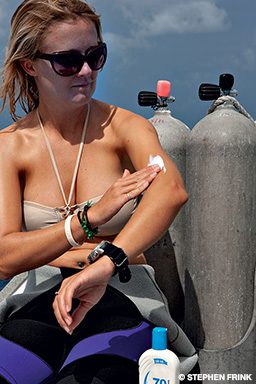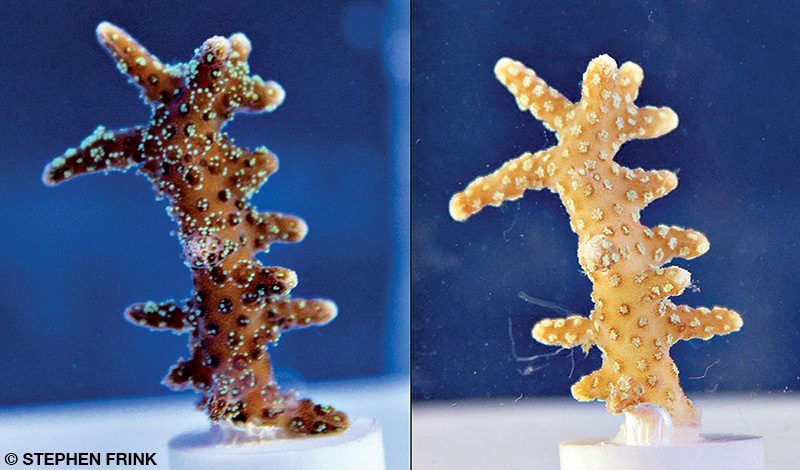Learn how to protect yourself and the environment.
Consumers who use sunscreen have both environmental and health questions about these products, especially as cities and states in the U.S. as well as Caribbean and Pacific destinations begin to either enact or consider sunscreen bans.
The ingredients and effects of commercially available sunscreens are controversial among health experts as well as ecologists. Most ingredients were grandfathered onto the current approved list because they were already in use when the U.S. Food and Drug Administration (FDA) began to regulate sunscreens.
Use of sunscreen, the most frequently used sun protection, is self-reported by 25 to 30 percent of fair-skinned people when they are in the sun for more than one hour. The biggest challenge in determining the effectiveness of sunscreen is something epidemiologists call “confounding by indication.” It is difficult to make a correlation because of the need to consider who is most likely to use sunscreen, who is most likely to burn and how these categories overlap.

Other considerations are the link between sunburns and cancer as well as the varied uptake of sunscreen application for people of different races, sexes and levels of outdoor activity. Skin can absorb sunscreen ingredients or body lotions, but the effects of these substances on a cellular level and on individual health are poorly understood. Scientists are now raising concerns about the effects of active ingredients in sunscreen on the immune, reproductive and endocrine systems.
Skin cancer is an especially controversial topic, with researchers studying the links between sunburns and melanoma, squamous cell carcinoma and basal cell carcinoma. While some evidence indicates that sunscreen lowers the risk of squamous cell carcinoma, researchers have not found strong evidence that sunscreen use prevents basal cell carcinoma. The topic needs further investigation.
Sunscreen is also a focus of environmental research. There are two types of sunscreen creams, and they are distinguished by their active ingredients. The active ingredients can be organic and absorb ultraviolet (UV) rays (e.g., oxybenzone, avobenzone, octocrylene and ecamsule) or mineral/inorganic and reflect UV rays (e.g., zinc oxide and titanium dioxide). Both types have the potential to penetrate skin and cause chemical reactions. Opinions differ about making a recommendation based on health effects, but the two types have different impacts on the marine environment.
We talked to Autumn Blum and Frazer Halliday, two industry leaders who promote eco-conscious sunscreen, to get answers to some frequently asked questions about the products currently available.
What are the problems with commercially available sunscreen?
Halliday: Not enough research has been conducted on the environmental impacts of sunscreen ingredients. Many ingredients such as oxybenzone cause coral bleaching, and some contain hormone (endocrine) disruptors that interrupt the reproductive cycles of sea life, which could have untold consequences for humans, fish, marine mammals and corals. Many of the commercially available products claim to be reef safe, but the opposite may be true.

Blum: The U.S. Food and Drug Administration (FDA) conducted a pilot study to determine if the active ingredients in sunscreen are absorbed into the body and bloodstream. The four organic ingredients they tested exceeded the levels that require extensive safety testing, which has yet to be done. After publishing the study in May 2019, the FDA is now calling for further toxicity and reproductive studies on 12 common sunscreen ingredients. Until these studies are conducted, the safest ingredients are zinc oxide and titanium dioxide.
An additional issue concerns nanominerals and non-nanominerals. Reducing the particle size of the active ingredient helps the sunscreen spread better. The FDA has declared nanominerals safe for use in sunscreens, but ecotoxicologists have declared them unsafe for the aquatic environment. If a label doesn’t specifically state non-nano zinc or non-nano titanium, or if the sunscreen goes on perfectly clear, it’s safe to assume it is not reef safe.
What evidence exists for reef damage from sunscreen, and what is the mechanism?
Blum: More than 3,000 published articles discuss sunscreen toxicity, with more than 1,000 articles referencing environmental toxicology. Methodology is often heavily debated, but there is enough science to cause concern. An often-referenced study, which was published in 2015 in the Archives of Environmental Contamination and Toxicology by Craig Downs, et al., showed that oxybenzone is highly toxic to juvenile coral and grossly deforms coral larvae. A concentration of oxybenzone of 62 parts per trillion is considered toxic and has been shown to be environmentally relevant. Significantly higher concentrations are found in Hawaii (>800 parts per trillion) and the U.S. Virgin Islands (>250 parts per billion). Other studies address the bioaccumulation of oxybenzone, octocrylene and octinoxate in edible fish tissues and the eggs of nesting sea birds. Based on environmental concentrations, these studies have also shown that sunscreen pollution is a symptom of unsustainable tourism.
Halliday: For our assessments, we largely rely on findings of research institutions that specifically focus on marine ecology and on organizations such as the Environmental Working Group (EWG). On November 26, 2019, the FDA will release new findings that will provide an updated list of ingredients that are “generally recognized as safe and effective,” but these results will not address the environmental concerns of using the ingredients in question.

Does reef-safe sunscreen really exist?
Blum: The term “reef safe” is not yet regulated by any official organization. Several recent studies have proven that chemical ingredients such as oxybenzone and nanoparticle zinc, which are found in many sunscreens labeled as reef safe, are unsafe for the environment. Consumers need to learn how to read ingredient labels, and they should rely on companies that test and share their results to ensure that the sunscreen is truly safe. Look for only non-nano titanium dioxide or non-nano zinc oxide, and avoid oxybenzone, octinoxate and octocrylene in the active ingredient listing and parabens, microbeads and formaldehyde-releasing preservatives in the inactive ingredients.
Some countries have banned the sale and use of substances such as oxybenzone and octinoxate. Will that solve the problem?
Blum: Awareness helps to drive change. Removing a known pollutant from popular reef destinations is a step in the right direction, but other sunscreen ingredients (such as octocrylene) that haven’t been as thoroughly tested are readily available, and some of these are still labeled as reef safe.
Halliday: It is urgent that we stop the broad use of these chemicals until we know their full consequences to people and the planet. The ban on oxybenzone is just the beginning, and there are at least 12 other commonly used ingredients that need urgent further investigation.
How can consumers determine if a sunscreen is safe for reefs and/or their health?
Blum: As conscious consumers are actively wanting to avoid oxybenzone and octinoxate, savvy marketing companies are replacing those ingredients with other molecularly similar ingredients such as avobenzone and octocrylene without doing any testing to ensure safety. Conscious consumers must learn to not trust the front of the bottle, which is unregulated, and instead read the active and inactive ingredients on the back label. Because little research exists about what is truly safe for our reefs, consumers can also view the company’s website to see if they are doing any real testing to validate their claims.

Halliday: Check that the active ingredients include only zinc oxide with or without titanium dioxide. Titanium dioxide alone may not provide full broad-spectrum protection. All other active ingredients are currently under scrutiny and require further research before they can be used safely. Always choose a sun protection factor (SPF) of 30 or higher, and ensure it is broad-spectrum and water-resistant.
What does SPF and broad-spectrum mean?
Blum: I like to remind people that SPF ratings are not linear. SPF 30 blocks nearly 97 percent of UVB rays; SPF 50 blocks about 98 percent. No sunscreen will effectively block 100 percent of UVB rays. SPF measures only UVB rays, which cause sunburns, but UVA rays are more likely to cause skin cancer because they penetrate more deeply into the skin. They also play a more important role in aging.
Looking for broad-spectrum ratings (sunscreens that offer protection from both UVA and UVB rays) on the label is more important than the SPF factor for true skin protection. Mineral sunscreens are more stable and do a better job reflecting UVA and UVB rays than chemical sunscreens.
What are some common mistakes when applying sunscreen?
Blum: When people switch from a traditional sunscreen to a mineral-based one, they often overapply the product or don’t spread it correctly. Apply sunscreen in front of a mirror until you get used to the process. Start by warming a pea-sized amount in the palms of both hands. Press your hands onto your face, and blend in the sunscreen before moving to the next area of your body. Other people like to use the spot method: Dot small amounts, and blend them in before moving to the next area of your body. Remember to reapply sunscreen when you get out of the water or every few hours.
Halliday: Some people do not apply enough sunscreen. The average adult needs about 1 ounce (equivalent to a shot glass) to fully cover the body. Most people apply only 25 to 50 percent of the recommended amount of sunscreen. Be careful not to miss areas such as ears, lips, neck, hairline, hands and feet. Spray sunscreens result in inadequate coverage and can be dangerous if inhaled. Excess droplets end up in the environment and never make it to your skin. Use sunscreen even on overcast days: Additional exposure from the sun reflecting off the water or sand can be just as harmful as the full sun. Wear your sunscreen daily, regardless of weather, to best protect your skin.

What else should you know about sunscreen?
Educate yourself. From a health perspective, make sure you purchase a sunscreen approved by the FDA. The FDA recently banned two additional substances — PABA and trolamine salicylate — based on research showing that these chemicals can contribute to immune system changes and other adverse health effects. Stay aware of the FDA regulations, including when they publish the results of the 16 substances they are currently testing. Read more at fda.gov/drugs/understanding-over-counter-medicines/sunscreen-how-help-protect-your-skin-sun.
Researchers continue to study and review sunscreen ingredients, but people must educate themselves using the information currently available to make a conscientious choice that balances their health with what’s best for the environment.
Consider multiple methods for sun protection. The best practices and most eco-friendly options currently available for your health and that of the reefs are to avoid direct sun exposure, especially between 10 a.m. and 2 p.m., actively seek shade and wear protective clothing such as a long-sleeve cotton shirt and a wide-brim hat.
The dive industry is becoming more aware of the issue, and many dive operators have moved their safety briefings to shaded areas on the boats. Some operators even provide hats and long-sleeve shirts for their customers.
Read the Label
Ingredients generally recognized as safe:
- titanium dioxide
- zinc oxide
Ingredients with insufficient data:
- avobenzone
- cinoxate
- dioxybenzone
- ensulizole
- homosalate
- meradimate
- octinoxate*
- octisalate
- octocrylene
- oxybenzone*
- padimate o
- sulisobenzone
Unsafe ingredients:
- PABA
- trolamine salicylate
*banned in Hawaii, Virgin Islands, Key West, Bonaire and Palau
Meet the Experts
AUTUMN BLUM is a cosmetic chemist who has been formulating award-winning products for the natural products industry for more than 20 years and is the CEO of an eco-conscious sunscreen brand. First certified as a diver in 1989, she is an experienced dive professional and technical diver.
FRAZER HALLIDAY is the cofounder and CEO of an eco-conscious sunscreen brand that will launch in 2020. He is a Professional Association of Diving Instructors (PADI) Divemaster, Royal Yachting Association (RYA) Yachtmaster and environmentalist who was spurred into action after seeing the effects of cosmetic and sunscreen ingredients on the ocean.
© Alert Diver — Q4 2019